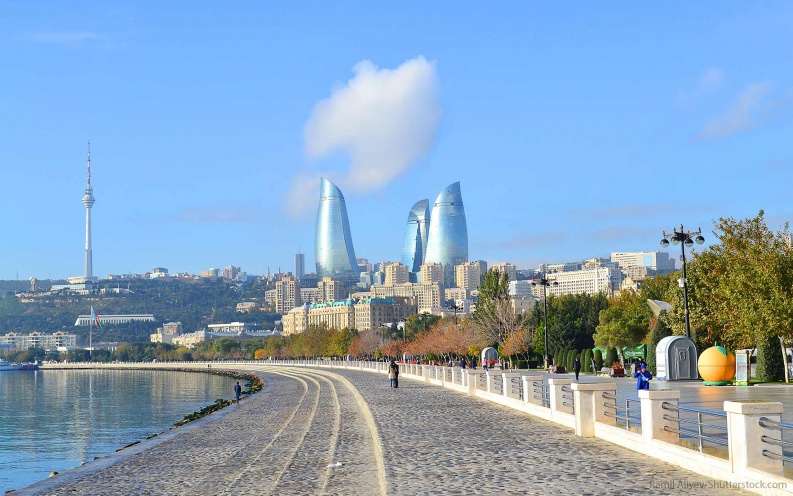Baku: Oriental fairy tale breathing history

By Amina Nazarli
Baku is one of the most fantastic places in the world, located at the meeting-point of Europe and Asia.
Few cities in the world are changing as quickly as Baku and
nowhere else in Eurasia, East and West blend as seamlessly and
chaotically as in this beautiful city.
An ancient civilization with enigmatic history dating back to 5500
BC and unique architecture, Baku is a compact city in which
visitors can easily walk around the city center to see most
attractions, along with a mix of architecture.
Baku is a city that lives with the bustling city life, but still managing to preserve its oriental fairy tale despite the modern charms of civilization.
Its heart, the UNESCO-listed Icherisheher or Old City lies within an exotically crenelated arc of fortress wall.
As time passes, the image of the city has also changed. Baku’s territory got expanded, going far beyond the charming Icherisheher, which seems frozen in time, remaining an eternal monument of ancient architecture.
Only here, inside the ancient walls of the Old City you can feel the touch of history, admire the ancient architecture and listen to local legends ... But once you raise your head everything changes: the city of the future is rising outside the old town with huge futuristic glass and concrete buildings of bizarre shapes and designs.
It’s easy to spend a whole day exploring this medieval walled
village, walking through the Palace of the Shirvanshahs, a
sandstone palace complex that was the home of northeastern
Azerbaijan’s ruling dynasty, and the tapering Maiden’s Tower, which
is Baku’s foremost architectural icon of millennia old.
Academician of the International Architecture Academy of oriental
countries, Ph.D of Architecture, Professor Ramiz Abdulrahimov told
Day.az that Icherisheher accommodates the most ancient buildings of
the city, preserving some of the oldest structures in the Middle
East region, relating to the VII-VI centuries BC.
Eurasia’s oil-boomtown began its rapid development since mid nineteenth-century, when history of oil industry started to grow in the city, attracting a large number of entrepreneurs from different countries of Europe including well-known businessmen like Siemens, the Nobel brothers and Rothschild.
“Baku also has local millionaires such as Haji Zeynalabdin Tagiyev, Murtuza Mukhtarov, Teymur Ashurbayov, Musa Nagiyev etc. Having grown rich on the oil industry, they sought to build European style villas and apartments. They built many buildings for ordinary people, in particular, Zeynalabdin Tagiyev tried to do a lot for people. He built a magnificent building of male and female gymnasiums, a lot of factories and plants,” the academician said.
Because of the lack of professional national architects, Baku millionaires began to invite specialists from Europe, who gave a unique look to the city.
Creating houses and buildings in the styles of their cultures and countries, the foreign specialists were also ordered to use Islamic elements in Baku’s architecture.
Thus just over 30-40 years the city’s appearance was replenished by beautiful mixture of Western and Islamic elements "neo-gothic", "neo-baroque", "neo-rococo” styles.
Those visiting the City of Winds recognize that Baku is the most
beautiful city of the South Caucasus.
In the last decade, countless towers have mushroomed, replacing
gloomy Soviet apartment blocks. Some of the finest new builds are
jaw-dropping masterpieces.
The capital city Baku is famous for its newly constructed "Flame
Towers", which becomes a symbol of Baku and modern cultural Heydar
Aliyev Center which is one of the world's five best
architectures.
Baku is not only a city, but also the largest port located on the west coast of the Caspian Sea, which is, in fact, the largest salt lake in the world.
Long and beautiful promenade called Boulevard with 8 km in
length, located on the shore of the Caspian Sea, is a favorite
place for walks for Bakunians and guests. Romantic couples canoodle
their way around wooded parks and hold hands on the Caspian-front
Boulevard, where greens and opal blues make a mockery of Baku’s
desert-ringed location.
Baku has a lot of historical and architectural monuments, belonging
to different periods of history. “Ateshgah” fire temple, existed
even before Islam, is located in 30 km in the south-eastern part of
Surakhani settlement of the Absheron peninsula.
The Temple, revered by Zoroastrians, appeared at the place of
"eternal" inextinguishable fires - burning natural gas output. This
is why the temple is called "Ateshgah", which means "House of
Fire", "the place of fire."
The open air museum is included in the UNESCO’s preliminary World
Heritage list and considered as one of the most interesting
monuments due to its historical value.
--
Amina Nazarli is AzerNews’ staff journalist, follow her on
Twitter: @amina_nazarli
Follow us on Twitter @AzerNewsAz
Here we are to serve you with news right now. It does not cost much, but worth your attention.
Choose to support open, independent, quality journalism and subscribe on a monthly basis.
By subscribing to our online newspaper, you can have full digital access to all news, analysis, and much more.
You can also follow AzerNEWS on Twitter @AzerNewsAz or Facebook @AzerNewsNewspaper
Thank you!
